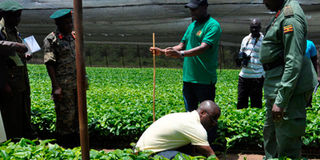Mobilising farmers to grow coffee for income

Gen Angina (R) looks on while Ambrose Byona shows him some of the coffee seedlings. Photo by JB Ssenkubuge
What you need to know:
- Government has intensified its campaigns to boost coffee farming, writes Ephraim Kasozi
For years, Sande Gorette has been growing food crops only to feed her family. The 33-year-old mother of four did not have an income to meet the needs that required money until three years ago when she was employed as a casual labourer at Kabango Coffee Nursery Centre.
“I came to the farm to work for money and I earn Shs240,000 per month. This money has been helping me to supplement the income of my husband to pay for school fees and meet other basic requirements,” she shares.
Sande explains that following various trainings on how to grow and benefit from coffee, she registered and was among the farmers who received coffee seedlings in the previous season.
The resident of Byabasiita Village, Kahunge Sub-county in Kamwenge District says she planted 500 seedlings distributed by the Operation Wealth Creation (OWC) programme. Unlike Sande, Anna Ampiire says she made the first harvest of 100 kilogrammes from her one acre land in December last year. “I started growing coffee immediately after training and the first harvest encouraged me to ask for more seedlings. I am now taking care of my farm for a better harvest to improve income,” says Ampiire.
Goal
Lt Gen Charles Angina, the deputy chief coordinator of OWC, says government is in the process of boosting coffee production seeking to raise 20 million bags by 2020 up from the current four million bags.
“To achieve our target as government, we are going to distribute 300 million coffee seedlings every year as a strategy to help our people eradicate poverty,” says Gen Angina.
Describing coffee growing as a strategy to achieve social economic transformation towards the middle income status, Gen Angina encouraged farmers to use all the idle land for coffee growing for income generation.
While allaying fears of possible loss of land, Gen Angina explains that the farmer groups will be formed and led by village people and any investment plan will be handled upon a consent signed by every individual land owner.
Angina suggests: “Due to global warming, there is need for research to come up with deep rooted coffee to match changes in climate.”
He was flagging off the distribution of 2.5 million coffee seedlings at Kabango Coffee Nursery in Byabasiita, Kamwenge District.
Impact
Benon Mwebembezi, the chairperson of coffee farmers’ platforms in Kamwenge District, describes the seedlings as a boost for farmers to engage in income generation. “We used to grow coffee in three sub-counties mainly because our district is a predominantly maize growing area. But with the intervention of OWC, at least 65 per cent of the farmers have planted coffee because it is the only cash crop with assured market,” he says.
What needs to be done
Ambrose Byona, the proprietor of seedling distributing company, Kabango Coffee Uganda Limited describes the distribution of 2.5 million seedlings as an increase from one million in 2015.
He says, “If government is to achieve the distribution of 300 million seedlings to achieve the targeted 20 million bags by 2020, there is need to review the price seedling from the current Shs300 to at least Shs600 because the price of inputs used to breed them has since gone up,” he says.
Byona also reveals that Shs300 per seedling is levied 6 percent withholding tax and payments delay which frustrates investment.
While appealing to Uganda Coffee Development Authority to certify seed suppliers in every district to encourage more investment, Byona says they are working at enhancing coffee growing in idle land owned by government aided schools to cultivate more than 720 acres of land.
“Coffee farms will be integrated with bananas for providing shade to coffee and food for students or as alternative income,” says Byona adding that he is working with partners to construct a coffee processing plant on the land provided by the district.
What it takes for one to grow coffee
Fischer Atuheire, an agribusiness manager, says a farmer needs to dig a two by two feet hole where you place the seedling.
He says that a farmer needs to mulch to keep water and moisture for the plant to survive in harsh or dry seasons and that a one acre piece of land requires 480 plants with spacing of 8 to10 feet. “It is about passion, interest because coffee plants need care to avoid weed,” he says.




